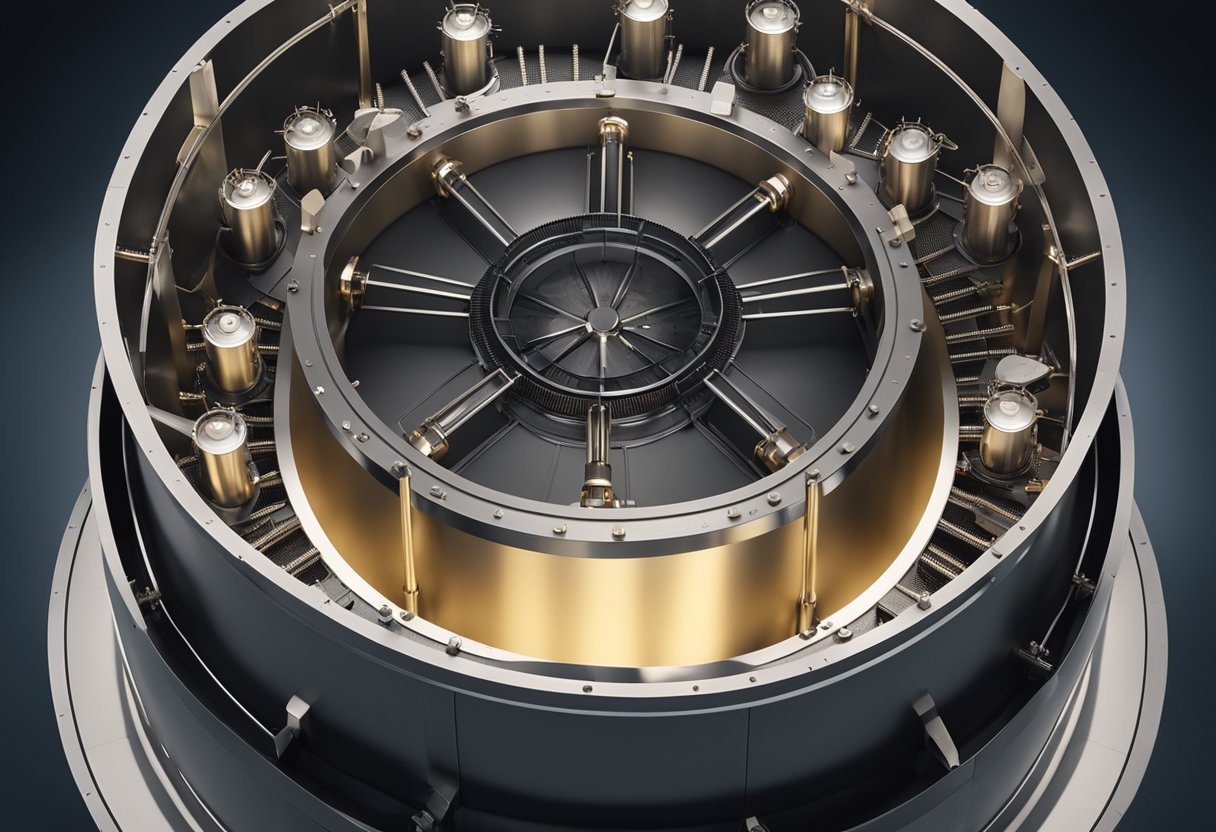
Nuclear thermal propulsion (NTP) represents a significant advancement in our quest to explore space. As a propulsion system, it leverages the heat generated by nuclear reactions, often from fission, to achieve far greater efficiency than traditional chemical rockets. This technology presents a novel method for propelling spacecraft, offering substantial benefits in performance, particularly for demanding missions such as crewed journeys to Mars.
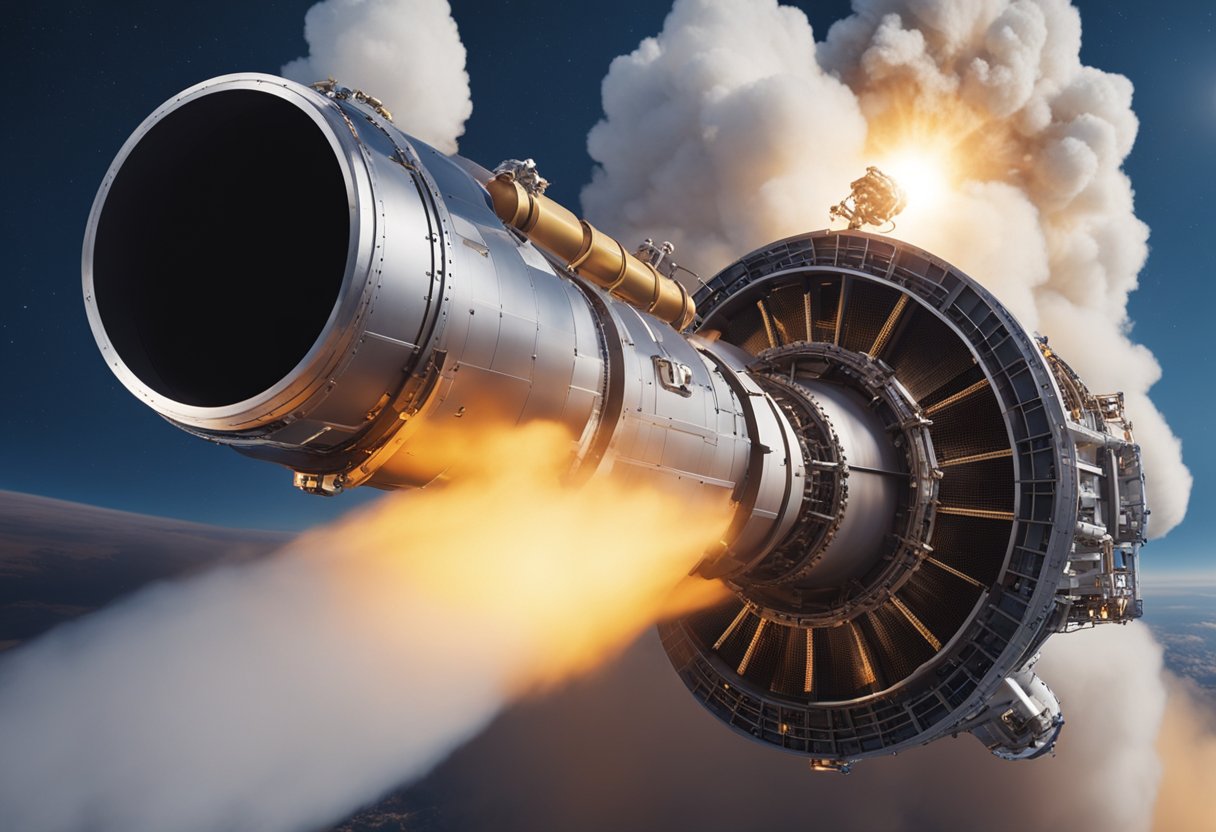
In contrast to chemical propulsion, NTP uses a reactor core to heat a propellant, typically hydrogen, which then expands and is expelled to produce thrust. This process results in a higher specific impulse, a measure of propulsion efficiency, making NTP potentially more suitable for deep space travel. The collaboration between NASA and the Department of Energy underscores the importance and potential of this technology, as they work together on the research, development, and anticipated demonstration of a functional nuclear thermal rocket.
Nuclear thermal propulsion (NTP) systems hold the key to revolutionising space travel by providing higher efficiency compared to traditional chemical engines. Through harnessing nuclear reactions, they offer significant improvements in spacecraft performance.
Nuclear thermal propulsion utilises a nuclear reactor to generate heat from nuclear fission. As opposed to chemical propulsion which relies on the combustion of propellants, nuclear thermal rockets work by passing a reactant — typically hydrogen — over a nuclear engine core. This causes the hydrogen to heat up and expand. The high-temperature gas then exits through a nozzle, producing thrust.
The measure of the efficiency of a rocket engine, specific impulse (Isp), is considerably higher in an NTP system. This is because the nuclear reaction within the reactor allows the propellant to reach far greater temperatures than chemical propellants can achieve, which translates into higher thermal propulsion.
Nuclear propulsion offers a marked advantage over traditional chemical systems. A primary benefit is the higher specific impulse (Isp), which effectively means that a spacecraft can travel further and faster on the same mass of fuel.
Chemical Propulsion:
Nuclear Thermal Propulsion:
The superiority of nuclear thermal rocket engines becomes particularly evident on longer, deep space missions, where carrying less fuel translates into being able to carry more scientific instruments or other payloads.
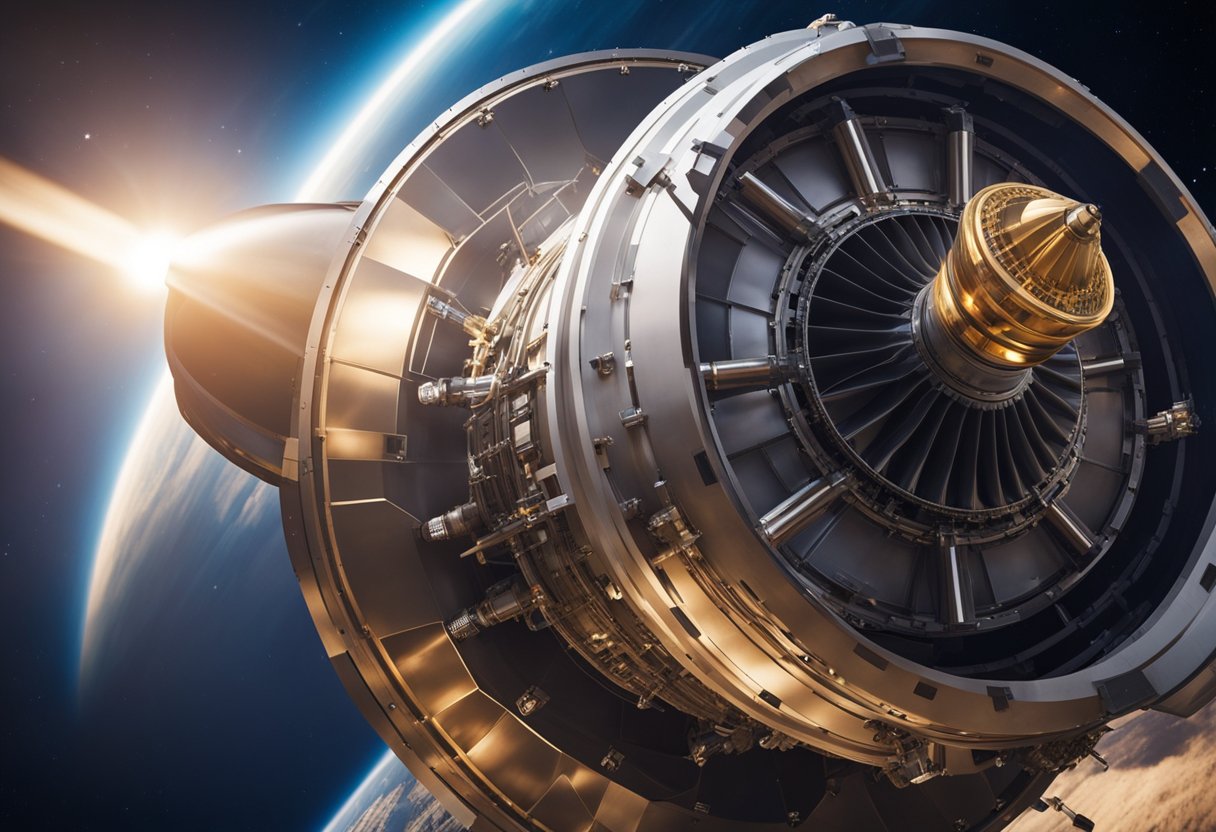
As experts in space propulsion, we recognise the critical milestones in nuclear thermal propulsion (NTP), which encompass efforts dating back to the mid-20th century and extending to contemporary advancements.
We first explore Project Rover, an initiative by the United States during the Cold War era to develop nuclear thermal rocket engines. Los Alamos National Laboratory spearheaded research beginning in 1955, generating a series of tests and advances that culminated in the NERVA (Nuclear Engine for Rocket Vehicle Application). The atomic energy commission and Congress supported these efforts considerably, recognising their potential for deep space exploration. This collaborative project demonstrated several engine designs, achieving hydrogen exit temperatures of approximately 2,400 K, and specific impulse (Isp) capabilities in the range of 825 to 875 seconds.
In recent years, there’s been a resurgence in interest for NTP due to its high efficiency and potential for missions beyond low Earth orbit. Agencies like DARPA and NASA actively explore advanced concepts like the Demonstration Rocket for Agile Cislunar Operations (DRACO), aiming to utilise nuclear thermal propulsion in more versatile and efficient ways. Our team keeps abreast of these developments, noting the trend towards using low enriched uranium or high-assay low enriched uranium to meet non-proliferation standards while still achieving efficient fission, as detailed in recent designs proposed by the Glenn Research Center.
These advancements in propulsion technology hold the promise of enhancing agile manoeuvres in cislunar space, the realm between Earth and the Moon, which is a zone of increasing interest not only for agencies but also for potential future endeavours in space tourism, as chronicled by outlets like SpaceVoyageVentures.com.
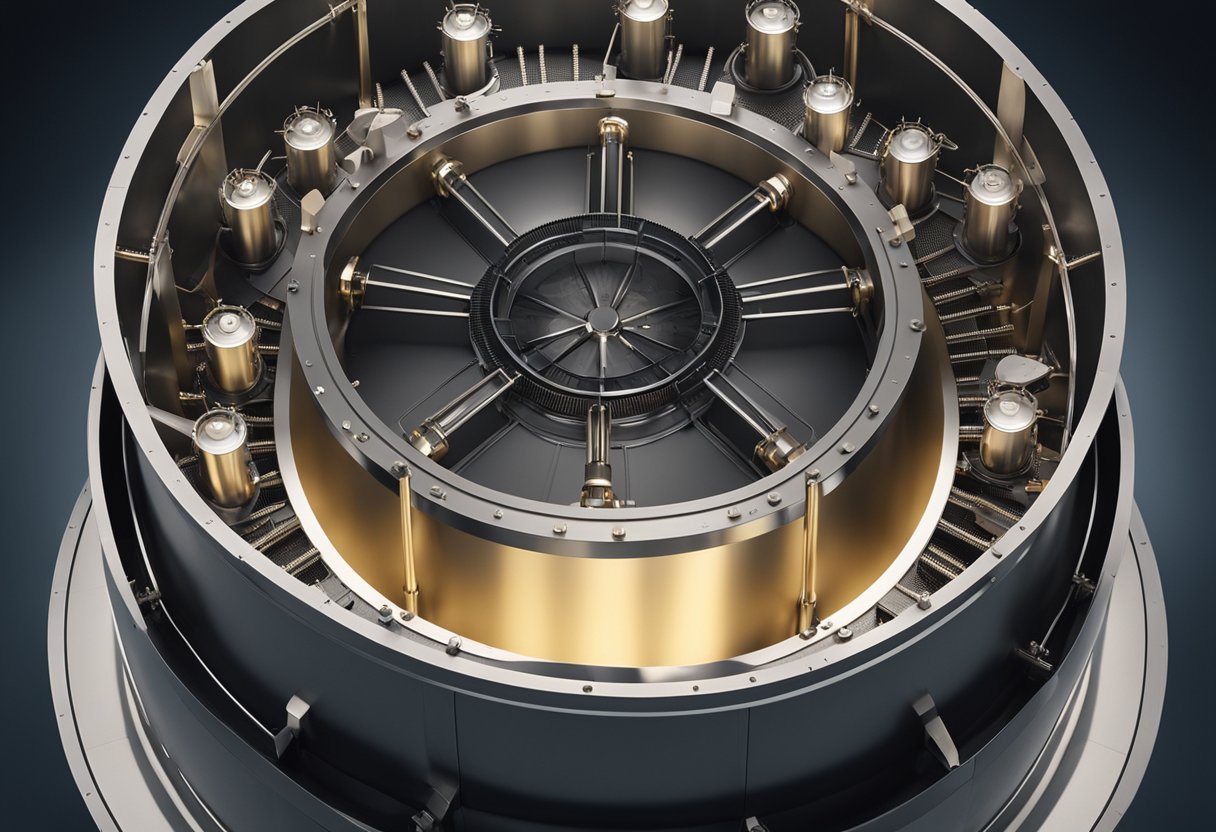
Our exploration into the intricate world of nuclear thermal propulsion reveals that the efficiency and safety of such a propulsion system hinge greatly on the specialisation of its fuel and reactor design.
Highly enriched uranium (HEU), often with a concentration of uranium-235 above 20%, has historically been the preferred choice for nuclear thermal propulsion due to its superior fission characteristics. However, due to proliferation risks, there’s a shift towards using low-enriched uranium (LEU), with uranium-235 content not exceeding 19.75%.
LEU presents various advantages in the context of nonproliferation and has been vetted by Idaho National Laboratory’s Transient Reactor Test (TREAT) facility for its performance. One of our primary considerations is ensuring a balanced fusion reaction while adhering to international nuclear regulation constraints, which posits a more robust argument for adopting LEU in our missions.
Maintaining the integrity of nuclear fuel in the severe thermal environments of space is crucial for successful missions. Fuel cladding made from materials resistant to high temperatures and radiation helps protect the nuclear fuel, ensuring the core’s longevity and reliability. One such material under consideration is a specific fuel composite currently under investigation for its resilience under harsh conditions.
The reactor core design is a critical aspect that dictates the propulsion system’s efficiency and safety. It consists of a meticulous arrangement of fuel elements, often cylindrical in design, where a reaction is initiated.
Our systems utilise hydrogen as a propellant, which, when passed through the reactor core containing nuclear fuel, absorbs the generated heat. The hydrogen then expands and is expelled to create thrust, a process facilitated by the fuel’s intense heat. It is insightful to know that this hydrogen not only serves as the propellant but also acts as a coolant to manage the reactor core’s temperatures, showcasing a dual role in nuclear thermal propulsion systems.
For efficient heat transfer and optimal performance, we integrate advanced thermal analysis of fuel elements into our design process. Innovation in cryogenic technology supports the storage and handling of liquid hydrogen, a complex endeavour vital for deep space propulsion. Our core design principles aim to maximise energy transfer while ensuring the reactor systems’ integrity is never compromised.
Advancements in fuel and reactor design are critical for the future of space exploration, whether it be for scientific endeavours or potential space tourism trips. Our commitment lies in the pursuit of sophisticated technologies to propel humanity further into the cosmos.
In a nuclear thermal propulsion (NTP) system, energy conversion and efficient heat transfer are fundamental. These systems harness the heat generated by nuclear reactions to create thrust, a process that is not only complex but highly dependent on the precise management of temperature and thermodynamics.
NTP systems operate on the principles of thermodynamics, where the nuclear reactor core generates high levels of heat from fission reactions. We utilise hydrogen as the propellant due to its low molecular weight and high efficiency in absorbing this heat. As the hydrogen passes through the reactor, it gets heated to extreme temperatures and expands rapidly. It is this expansion of hydrogen gas through a nozzle that produces thrust, propelling the spacecraft forward. The efficiency of this process is crucial, determined by the specific impulse, which reflects the change in momentum delivered per unit of propellant consumed.
The core aspect of an NTP system is the energy conversion from nuclear fission to kinetic energy of the exhaust gases. The heat transfer mechanism involves conducting the heat generated by the reactor to the hydrogen propellant. This is a pivotal process where thermodynamics heavily influences the propulsion system’s performance. Efficient heat transfer leads to a hotter gas and, thus, a higher specific impulse, which is a significant advantage over conventional chemical rockets. The NERVA (Nuclear Engine for Rocket Vehicle Application) program exemplifies the utilisation of these principles to achieve efficient propulsion, doubling the specific impulse compared to today’s chemical rockets.
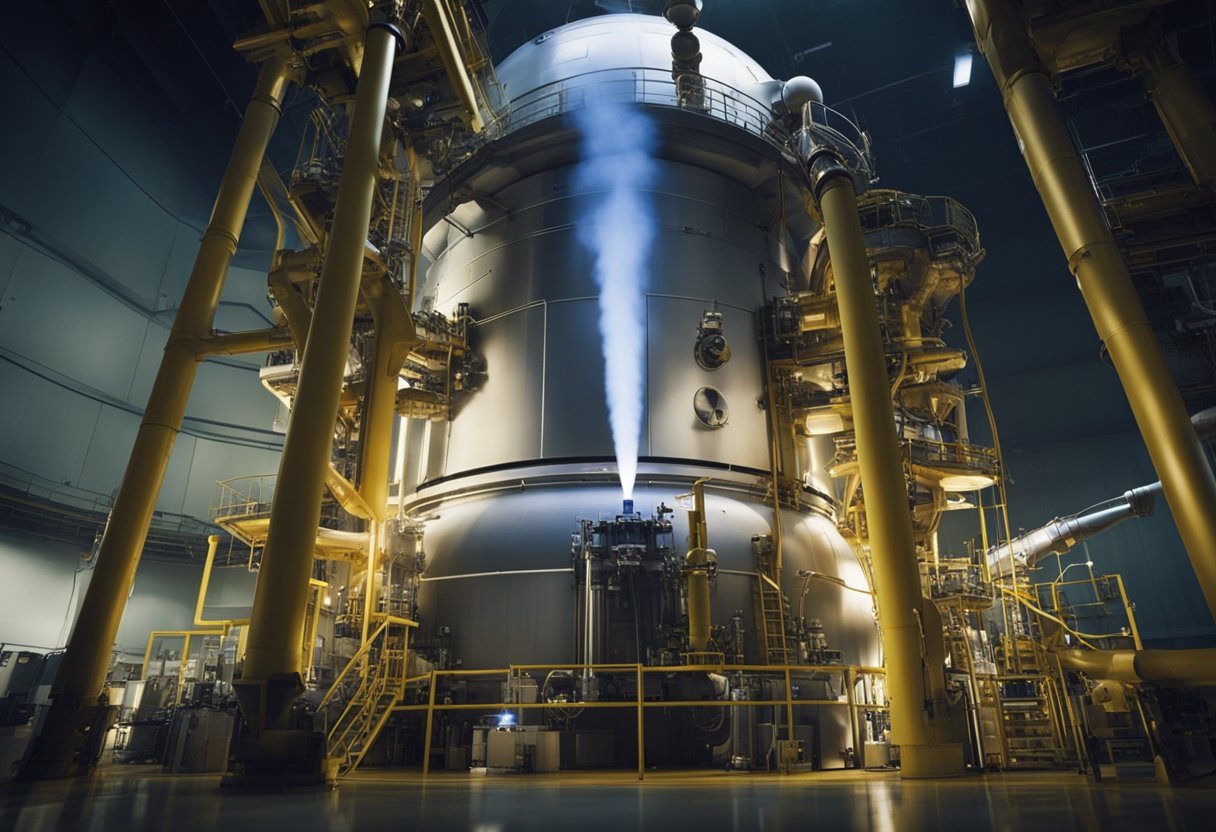
In the field of Nuclear Thermal Propulsion (NTP), we recognise hydrogen as a crucial component due to its exceptional properties as a propellant.
Hydrogen is selected as a propellant in NTP systems primarily because of its low molecular weight and high specific impulse. When used as a propellant, hydrogen absorbs the considerable thermal energy produced by the reactor, allowing the exhaust to be expelled at very high velocities. This thermal-hydraulic behaviour of hydrogen is complex, as it involves not only typical propulsion challenges but also high-temperature physics and respective chemical reactions due to the reaction environment imposed by the NTP reactor operation.
The advantages of using hydrogen are multifaceted. It offers the highest efficiency compared to other propellants, which is measured in terms of specific impulse—a crucial metric in rocket propulsion that signifies the change in momentum per unit of propellant.
Moreover, hydrogen’s low density facilitates storage in large quantities to empower long-duration missions. This makes it a significant driver for space exploration, including but not limited to, possible applications in interplanetary missions or even early space tourism ventures, where efficiency and endurance are paramount.
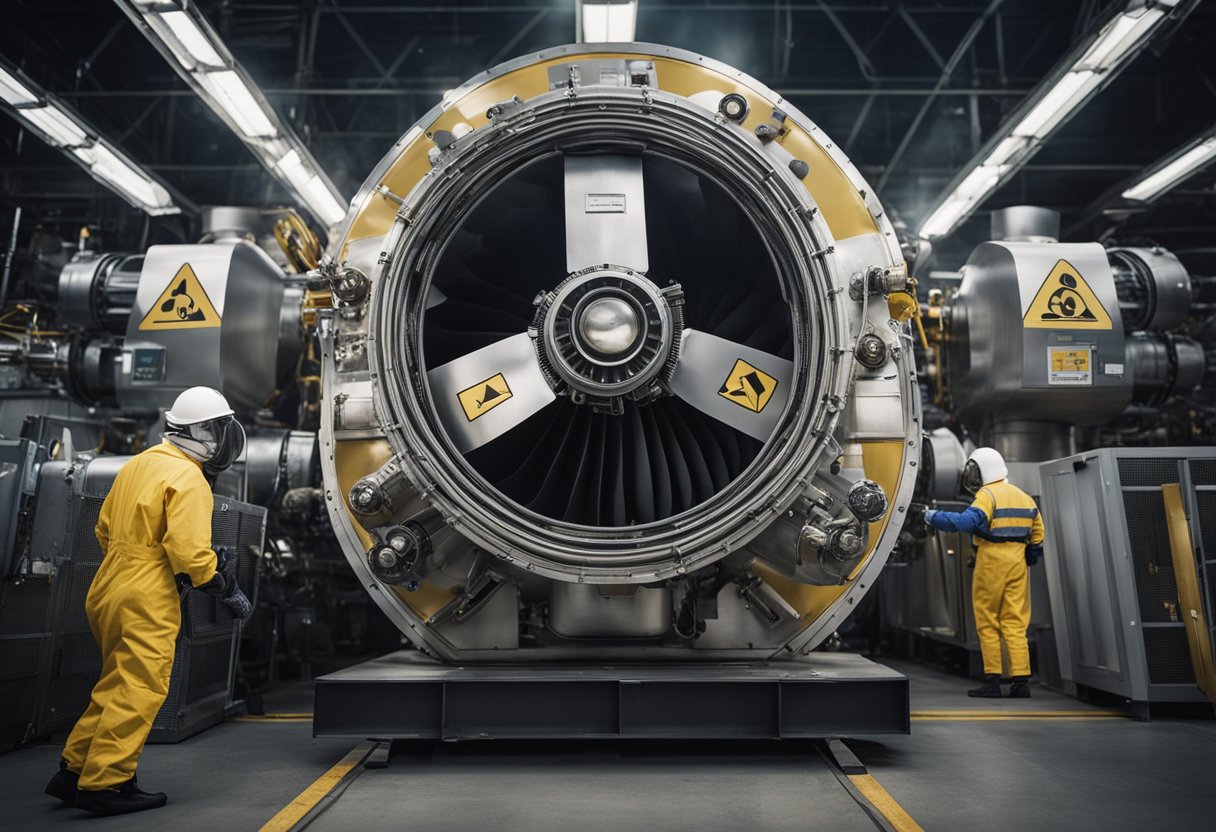
In our exploration of nuclear thermal propulsion (NTP), we recognise the significant safety and radiation concerns inherent in the technology. These concerns centre around the potential radiation exposure during the operation of NTP and the subsequent environmental impact.
Radiation is a key challenge for NTP systems. We focus on designing effective radiation shielding to protect the crew and electronic equipment from high levels of ionising particles produced during fission. Sophisticated materials and engineering solutions are critical in achieving this aim. For example, there’s a detailed analysis of possible accident scenarios and how design can counter these challenges.
Materials like tungsten and high-density plastics are among those evaluated for their shielding properties. They are used to absorb or deflect harmful radiation, thereby reducing the potential for damage to both human health and sensitive components aboard spacecraft.
The environmental impact of NTP is a concern from both an operational standpoint and in the unfortunate event of an accident. The safe containment of radioactive materials is paramount to prevent contamination. The NASA’s Glenn Research Center is leading research to address these concerns, looking at all the components of an NTP system and their potential environmental consequences.
We consider the lifecycle of the propulsion system, from construction through to disposal, ensuring that safety protocols are adhered to at each stage. During launch, operation, and in any potential disposal of an NTP system, we strive to mitigate any environmental impact. This includes planning for containment and potential decontamination processes that might be necessary in the event of a system failure.
Before we introduce the intricacies of materials and manufacturing pertinent to Nuclear Thermal Propulsion (NTP), it’s crucial to understand that the selection of materials and their fabrication methods are pivotal to the success of NTP systems. Issues such as erosion within the reactor pose ongoing challenges, necessitating advanced materials that can withstand the harsh conditions of space.
In the realm of NTP, materials science is foundational. Our focus centres on developing robust cermet fuels, an amalgamation of ceramics and metals, which demonstrate exceptional resistance to high temperatures and corrosive environments. One notable advance is documented in the Fabrication and Testing of CERMET Fuel Materials, underscoring the necessity for materials that can endure the rigorous conditions of space nuclear propulsion.
The radiation environment in space further complicates material selection. It is critical that our materials resist not only thermal and mechanical stress but also radiation-induced damage which can lead to erosion and degradation. Thus, ongoing research informs our growing repository of suitable materials for NTP.
The fabrication of NTP-related components is a sophisticated process demanding precision and innovation. We engage in manufacturing processes that involve the intricate joining of different materials to construct a reactor capable of operating efficiently in space. Techniques such as vacuum hot pressing for cermet fuels are employed, as detailed in An Overview of CERMET Fuel Development.
Our manufacturing endeavours also aim to validate the endurance of these materials against erosion by simulating the extreme conditions of space. This is exemplified in the development of the Nuclear Thermal Rocket Element Environmental Simulator (NTREES), an apparatus designed to mimic the intense heat and radiation that propulsion systems will encounter beyond Earth’s atmosphere.
Through meticulous selection of materials and advanced fabrication, we ensure that our space nuclear propulsion technology not only meets but exceeds the rigorous standards required for eventual application in space exploration and travel; this includes those voyages documented by emerging space tourism outlets like SpaceVoyageVentures.com. Our endeavours in materials and fabrication are foundational to the viability and success of propulsion systems for navigating the final frontier.
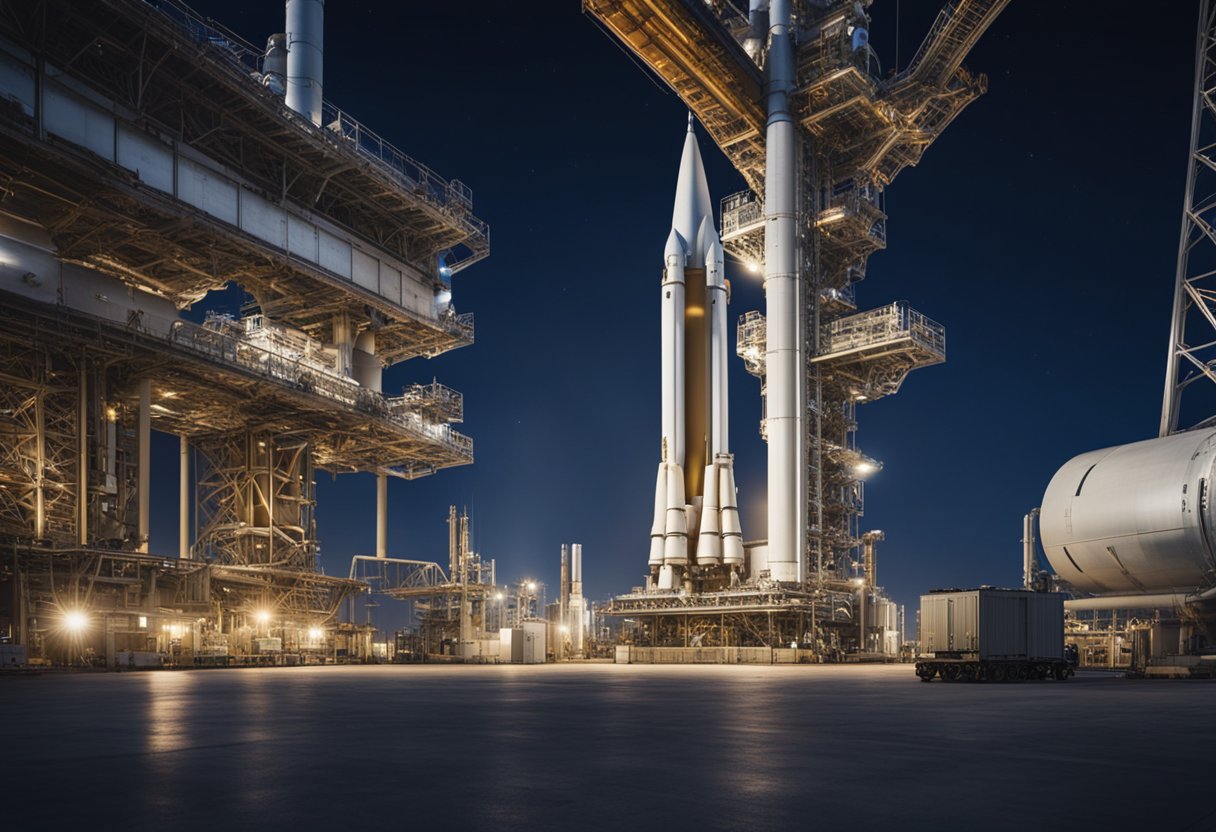
When planning missions that utilise nuclear thermal propulsion (NTP), establishing a detailed mission architecture and logistics framework is pivotal. We must ensure the integration of NTP systems aligns with spacecraft requirements while addressing the complexities of launch and assembly in space to promote a successful mission, potentially to Mars.
Integrating NTP systems into spacecraft is a process that demands meticulous engineering to marry propulsion with payload capacity. Our attention firstly focuses on the thermal management systems, essential given the high temperatures of NTP, to safeguard spacecraft components. Additionally, the thrust structure must be robust, able to translate the high thrust from NTP efficiently. For instance, the design of a crewed Mars mission can be significantly influenced by NTP’s capacity to reduce travel time, enhancing crew safety and reducing exposure to space radiation.
Considering launch and assembly, our operations start from the ground up. We meticulously plan the sequence of launches; nuclear propulsion elements are often sent separately from crew modules due to safety and regulatory concerns. On-orbit assembly then represents a cornerstone of our logistics, requiring unprecedented precision. Using automated systems or astronaut-led Extravehicular Activities (EVAs), we assemble multiple stages in low Earth orbit before embarking on the journey to Mars. This intricate dance of logistics and engineering ensures that each component is not only launched and assembled effectively but also orchestrated perfectly for the mission’s subsequent phases.
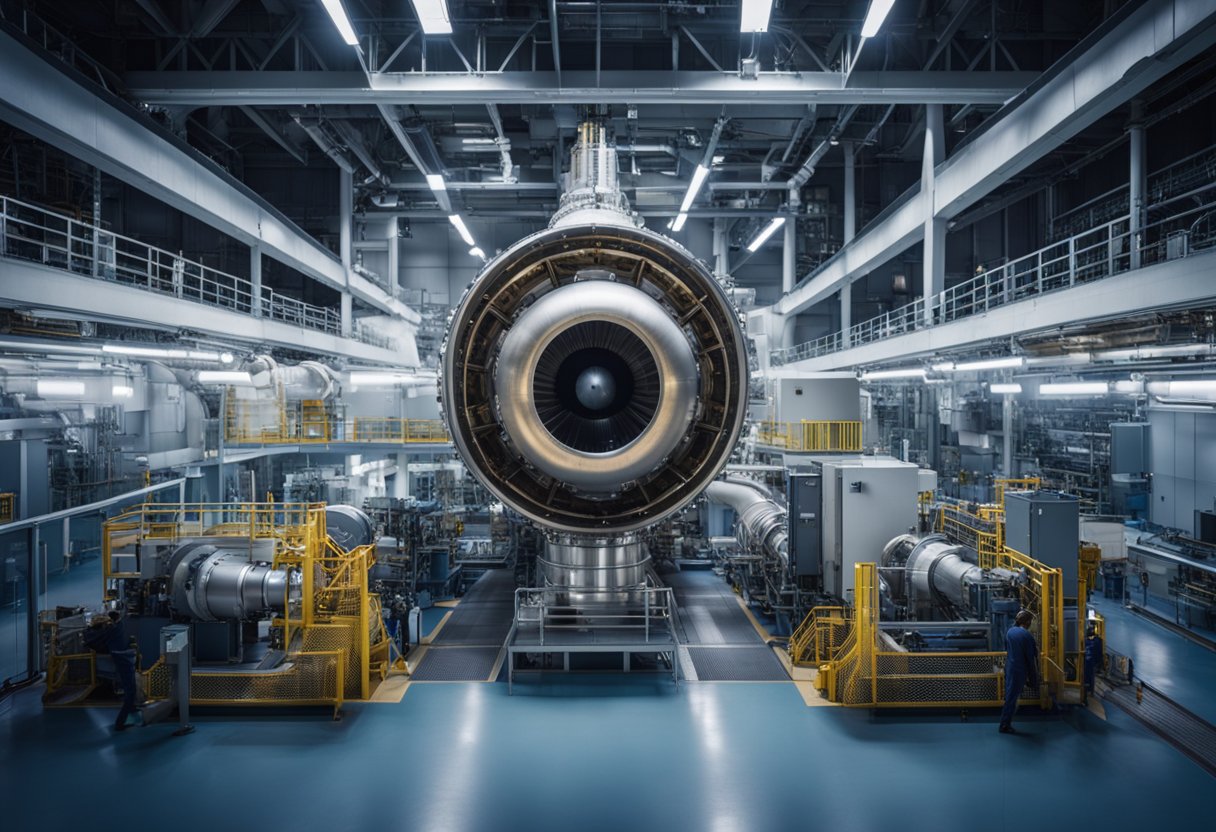
Our collaboration with the Department of Energy (DOE) is instrumental in advancing the nuclear thermal propulsion (NTP) technology, vital for future deep-space missions. This partnership leverages each organisation’s expertise, facilities, and resources for the development of efficient and reliable NTP systems.
We are working closely with the DOE to design and develop nuclear thermal propulsion systems. As part of this collaborative effort, we initiated a request for proposals which led to the selection of three industry teams to develop preliminary reactor design concepts. These designs are critical for the NTP system as they aim to employ high-assay low-enriched uranium fuel. The DOE, along with Idaho National Laboratory, plays a crucial role in supporting these developmental efforts.
Our collaboration extends to utilising DOE’s test facilities such as the Transient Reactor Test Facility, which is essential for examining the reactor concepts under relevant conditions. Additionally, our Marshall Space Flight Center in Huntsville, Alabama, is a key location where much of the NTP development occurs. Here, our engineers and scientists conduct a range of tests and simulations to ensure the technology can meet the rigorous demands of space travel.
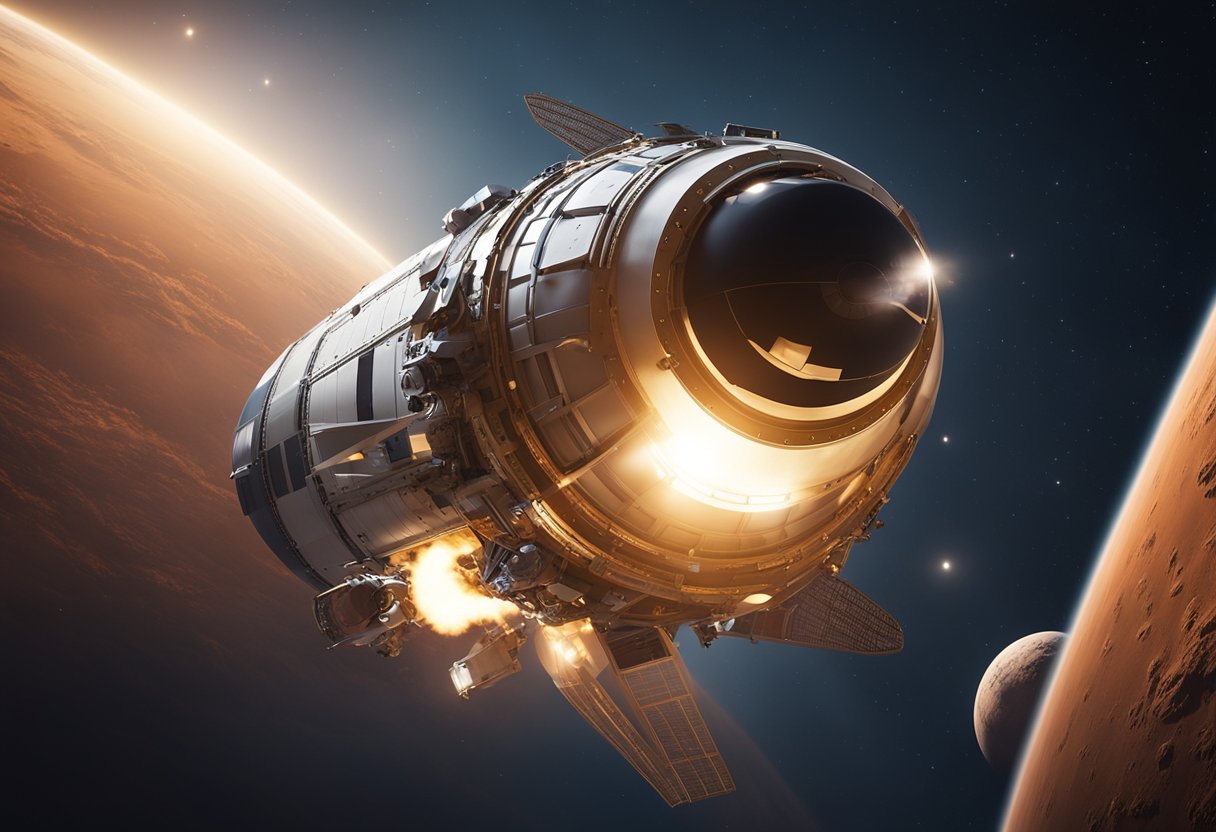
Nuclear Thermal Propulsion (NTP) presents a transformative advantage for human exploration of Mars by substantially reducing travel time and increasing mission flexibility.
With NTP, we can shorten the journey to Mars from months to possibly weeks, thus reducing the risks associated with prolonged exposure to space radiation and microgravity. The propulsion system combines a moderate-to-high thrust with a more efficient specific impulse compared to traditional chemical propulsion, which can be particularly beneficial for carrying larger payloads and crews to the Red Planet.
Moreover, NASA and DARPA are actively working on testing a nuclear thermal engine, highlighting the ongoing commitment to integrating NTP technology into future missions.
Once we arrive at Mars, NTP could be pivotal in sustaining human presence on the planet. This propulsion technology can facilitate more frequent trips, supporting the transfer of supplies and personnel necessary to establish a permanent base. The high specific impulse of NTP engines also opens the possibility for more complex missions, like crewed exploration of the martian moons, Phobos and Deimos.
Lockheed Martin has introduced a configuration of Mars Base Camp with NTP, which can significantly enhance our capabilities for a sustained presence and comprehensive exploration of the Martian system within our solar system.
As we advance into an era where space exploration goes beyond preliminary probes and rovers, nuclear thermal propulsion (NTP) emerges as a pioneering technology set to redefine our capabilities in the cosmos.
In recent years, NTP technology has seen substantial advancements with numerous research initiatives aiming to increase its viability for space exploration. One significant aspect of current research focuses on enhancing the efficiency of the fission process used within NTP systems. By directly heating propellant, usually hydrogen, to produce thrust, NTP can potentially offer twice the efficiency of traditional chemical rockets. Our involvement in the initial design and testing phases positions us as central players in advancing this technology.
Innovations in materials science are also crucial as they address the challenges related to reactor design and durability in the harsh conditions of space. Research is also honing in on the technology’s scalability and the management of radioactive materials in safe and effective ways.
While NTP is being keenly developed with the Mars mission in mind, its implications stretch well into the broader expanse of space. The high specific impulse and considerable thrust output of NTP systems point towards unprecedented possibilities for deep space exploration. We are committed to exploring the use of NTP for potential manned missions not just to Mars, but also to our outer planet neighbours and possibly beyond the confines of our solar system.
Moreover, as commercial interest in space travel grows, our foresight into how NTP could facilitate faster travel times may play a pivotal role in emerging space tourism ventures, such as those documented on websites like SpaceVoyageVentures.com. We envisage NTP as a technology that could, one day, be integral to making human experience and interaction in space a routine occurrence.
In this section, we explore the commonly posed queries concerning nuclear thermal propulsion—unlocking the subtleties of its function, potential, distinctions from other propulsion methods, and benefits for space exploration.
Nuclear thermal propulsion (NTP) operates by passing a propellant, usually hydrogen, through a reactor core where it is heated by nuclear fission before being expelled to generate thrust. This process harnesses the heat produced from the splitting of uranium atoms.
A nuclear thermal rocket can achieve velocities that are significantly higher than traditional chemical rockets. With a specific impulse (Isp) potentially above 900 seconds, roughly double that of the most advanced chemical engines, NTP systems promise rapid transit times in space.
Nuclear thermal propulsion provides high thrust by directly heating a propellant, whereas nuclear electric propulsion (NEP) uses nuclear energy to generate electricity, which then powers an ion thrust system. NEP is typically more efficient, but delivers lower thrust compared to NTP.
Nuclear thermal propulsion offers several advantages including a high energy density, reduced mission duration, and the capacity for a heavier payload. These features significantly expand the possibilities for crewed missions to Mars and other deep-space explorations.
While nuclear thermal propulsion technology is not currently in operation, there are advancements in research and development. As of now, a flight demonstration design is in planning stages, indicating progress towards a working NTP system.
The adoption of nuclear propulsion for spacecraft has been limited due to several factors, including technological complexity, high development costs, safety concerns, and regulatory hurdles. Despite these challenges, our understanding and capacity to safely utilise nuclear propulsion is advancing, signalling potential future integration into space travel.